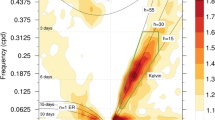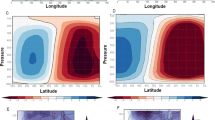Abstract
An idealized large eddy simulation (LES) has been performed to understand the dynamics of cumulus clouds over the Bay of Bengal using the Weather Research and Forecasting (WRF) model. Cumulus clouds play a key role in the atmospheric convection process. However, despite their importance, they are not well represented in global climate models (GCMs). Moreover, cumulus clouds involve a transition from shallow to deep clouds (or congestus clouds), and GCMs are unable to capture this phenomenon. The development of cumulus clouds is very pronounced over the Bay of Bengal region, and its dynamics has not yet been fully explored. In the present study, a gradual transition phenomenon of shallow cumulus to deep cumulus (congestus) at the development stage and understanding the evolution of clouds and flux transport is investigated. Different cloud parameters at shallow and deep cumulus congestus stages are examined. It is observed that the shallow clouds have a higher magnitude of entrainment than that of deep clouds, and the rate of decrease in entrainment with height is also higher for the shallow clouds. Moreover, the detrainment rate is higher in the case of shallow cumulus clouds as well. This means that as the clouds have transitioned from shallow cumulus to deep congestus clouds, both entrainment and detrainment rates decrease. This important finding will be quite useful in developing future parameterizations for cumulus clouds. A negative correlation between the entrainment rate and cloud core vertical velocity is observed which is supported by previous studies.










Similar content being viewed by others
Data availability
Data can be made available on request.
References
Arakawa, A., & Schubert, W. H. (1974). Interaction of a cumulus cloud ensemble with the large-scale environment part I. Journal of the Atmospheric Sciences, 31(3), 674–701.
Bera, S. (2021). Droplet spectral dispersion by lateral mixing process in continental deep cumulus clouds. Journal of Atmospheric and Solar Terrestrial Physics, 214, 105550. https://doi.org/10.1016/j.jastp.2021.105550
Bera, S., & Prabha, T. V. (2019). Parameterization of entrainment rate and mass flux in continental cumulus clouds: Inference from large eddy simulation. Journal of Geophysical Research Atmospheres, 124(23), 13127–13139.
Betts, A. K. (1975). Parametric interpretation of trade-wind cumulus budget studies. Journal of Atmospheric Sciences, 32(10), 1934–1945.
Bhat, G. S., Gadgil, S., Kumar, P. H., Kalsi, S. R., Madhusoodanan, P., Murty, V. S. N., Rao, C. P., Babu, V. R., Rao, L. V. G., Rao, R. R., & Ravichandran, M. (2001). BOBMEX: The Bay of Bengal monsoon experiment. Bulletin of the American Meteorological Society, 82(10), 2217–2244.
Böing, S. J., Jonker, H. J., Siebesma, A. P., & Grabowski, W. W. (2012). Influence of the subcloud layer on the development of a deep convective ensemble. Journal of the Atmospheric Sciences, 69(9), 2682–2698.
Dawe, J. T., & Austin, P. H. (2013). Direct entrainment and detrainment rate distributions of individual shallow cumulus clouds in an LES. Atmospheric Chemistry and Physics, 13(15), 7795–7811.
De Rooy, W. C., Bechtold, P., Fröhlich, K., Hohenegger, C., Jonker, H., Mironov, D., Pier Siebesma, A., Teixeira, J., & Yano, J. I. (2013). Entrainment and detrainment in cumulus convection: An overview. Quarterly Journal of the Royal Meteorological Society, 139(670), 1–19.
Derbyshire, S. H., Beau, I., Bechtold, P., Grandpeix, J. Y., Piriou, J. M., Redelsperger, J. L., & Soares, P. M. M. (2004). Sensitivity of moist convection to environmental humidity. Quarterly Journal of the Royal Meteorological Society A Journal of the Atmospheric Sciences, Applied Meteorology and Physical Oceanography, 130(604), 3055–3079.
Fiedler, S., Crueger, T., D’Agostino, R., Peters, K., Becker, T., Leutwyler, D., Paccini, L., Burdanowitz, J., Buehler, S. A., Cortes, A. U., & Dauhut, T. (2020). Simulated tropical precipitation assessed across three major phases of the coupled model intercomparison project (CMIP). Monthly Weather Review, 148(9), 3653–3680.
Gregory, D., Kershaw, R., & Inness, P. M. (1997). Parametrization of momentum transport by convection. II: Tests in single-column and general circulation models. Quarterly Journal of the Royal Meteorological Society, 123(541), 1153–1183.
Hawkins, E., & Sutton, R. (2011). The potential to narrow uncertainty in projections of regional precipitation change. Climate Dynamics, 37(1), 407–418.
Hohenegger, C., & Stevens, B. (2013). Preconditioning deep convection with cumulus congestus. Journal of the Atmospheric Sciences, 70(2), 448–464.
Johnson, R. H., Rickenbach, T. M., Rutledge, S. A., Ciesielski, P. E., & Schubert, W. H. (1999). Trimodal characteristics of tropical convection. Journal of Climate, 12(8), 2397–2418.
Khairoutdinov, M. F., Krueger, S. K., Moeng, C. H., Bogenschutz, P. A., & Randall, D. A. (2009). Large-eddy simulation of maritime deep tropical convection. Journal of Advances in Modeling Earth Systems, 1, 4.
Khairoutdinov, M., & Randall, D. (2006). High-resolution simulation of shallow-to-deep convection transition over land. Journal of the Atmospheric Sciences, 63(12), 3421–3436.
Kirshbaum, D. J. (2011). Cloud-resolving simulations of deep convection over a heated mountain. Journal of the Atmospheric Sciences, 68(2), 361–378.
Kuang, Z., & Bretherton, C. S. (2006). A mass-flux scheme view of a high-resolution simulation of a transition from shallow to deep cumulus convection. Journal of the Atmospheric Sciences, 63(7), 1895–1909.
Lim, K. S. S., & Hong, S. Y. (2010). Development of an effective double-moment cloud microphysics scheme with prognostic cloud condensation nuclei (CCN) for weather and climate models. Monthly Weather Review, 138(5), 1587–1612.
Lu, C., Liu, Y., Zhang, G. J., Wu, X., Endo, S., Cao, L., & Guo, X. (2016). Improving parameterization of entrainment rate for shallow convection with aircraft measurements and large-eddy simulation. Journal of the Atmospheric Sciences, 73(2), 761–773.
Masunaga, H., L’Ecuyer, T. S., & Kummerow, C. D. (2005). Variability in the characteristics of precipitation systems in the tropical Pacific. Part I: Spatial structure. Journal of Climate, 18(6), 823–840.
Murata, A., & Ueno, M. (2005). The vertical profile of entrainment rate simulated by a cloud-resolving model and application to a cumulus parameterization. Journal of the Meteorological Society of Japan, 83(5), 745–770.
Neggers, R. A. J., Siebesma, A. P., & Jonker, H. J. J. (2002). A multiparcel model for shallow cumulus convection. Journal of the Atmospheric Sciences, 59(10), 1655–1668.
Ooyama, K. (1971). A theory on parameterization of cumulus convection. Journal of the Meteorological Society of Japan Series II, 49, 744–756.
Rieck, M., Hohenegger, C., & van Heerwaarden, C. C. (2014). The influence of land surface heterogeneities on cloud size development. Monthly Weather Review, 142(10), 3830–3846.
Riehl, H., & Malkus, J. (1961). Some aspects of hurricane Daisy, 1958. Tellus, 13(2), 181–213.
Schiro, K. A., & Neelin, J. D. (2019). Deep convective organization, moisture vertical structure, and convective transition using deep-inflow mixing. Journal of the Atmospheric Sciences, 76(4), 965–987.
Siebesma, A. P., Bretherton, C. S., Brown, A., Chlond, A., Cuxart, J., Duynkerke, P. G., et al. (2003). A large-eddy simulation intercomparison study of shallow cumulus convection. Journal of the Atmospheric Sciences, 60(10), 1201–1219.
Siebesma, A. P., & Cuijpers, J. W. M. (1995). Evaluation of parametric assumptions for shallow cumulus convection. Journal of Atmospheric Sciences, 52(6), 650–666.
Stirling, A. J., & Stratton, R. A. (2012). Entrainment processes in the diurnal cycle of deep convection over land. Quarterly Journal of the Royal Meteorological Society, 138(666), 1135–1149.
Stull, R. B. (1988). An Introduction to Boundary Layer Meteorology (Vol. 13). Springer.
Sukanya, P., & Kalapureddy, M. C. R. (2021). Cloud radar observations of multi-scale variability of cloud vertical structure associated with Indian summer monsoon over a tropical location. Climate Dynamics, 56, 1055–1081. https://doi.org/10.1007/s00382-020-05520-y
Tan, Z., Kaul, C. M., Pressel, K. G., Cohen, Y., Schneider, T., & Teixeira, J. (2018). An extended eddy-diffusivity mass-flux scheme for unified representation of subgrid scale turbulence and convection. Journal of Advances in Modeling Earth Systems, 10, 770–800.
Tompkins, A. M. (2001). Organization of tropical convection in low vertical wind shears: The role of cold pools. Journal of the Atmospheric Sciences, 58(13), 1650–1672.
Wu, X., Deng, L., Song, X., & Zhang, G.-J. (2007). Coupling of convective momentum transport with convective heating in global climate simulations. Journal of the Atmospheric Sciences, 64, 1334–1349.
Yang, S., & Smith, E. A. (2006). Mechanisms for diurnal variability of global tropical rainfall observed from TRMM. Journal of Climate, 19(20), 5190–5226.
Zhang, G. J., & Mu, M. (2005). Simulation of the Madden–Julian oscillation in the NCAR CCM3 using a revised Zhang–McFarlane convection parameterization scheme. Journal of Climate, 18(19), 4046–4064.
Zhang, Y., & Klein, S. A. (2010). Mechanisms affecting the transition from shallow to deep convection over land: Inferences from observations of the diurnal cycle collected at the ARM Southern Great Plains site. Journal of the Atmospheric Sciences, 67(9), 2943–2959.
Zhuang, Y., Fu, R., Marengo, J. A., & Wang, H. (2017). Seasonal variation of shallow-to-deep convection transition and its link to the environmental conditions over the Central Amazon. Journal of Geophysical Research Atmospheres, 122(5), 2649–2666.
Acknowledgements
The authors thank the IIT Delhi HPC facility for computational resources and G.S. Bhat for providing BOBMEX data. The research has been partially funded by the DST Centre of Excellence in Climate Modeling at the Indian Institute of Technology Delhi, New Delhi, India. The Indian Institute of Tropical Meteorology is funded by the Ministry of Earth Sciences, Govt. of India.
Author information
Authors and Affiliations
Contributions
GD and SB conceptualized the work. GD performed computations, prepared figures and wrote the manuscript. SB helped in preparing the manuscript. AD and SS reviewed the manuscript.
Corresponding author
Ethics declarations
Conflict of interest
The authors declare that they have no known competing financial interests that could have appeared to influence the work reported in this paper.
Additional information
Publisher's Note
Springer Nature remains neutral with regard to jurisdictional claims in published maps and institutional affiliations.
Rights and permissions
Springer Nature or its licensor (e.g. a society or other partner) holds exclusive rights to this article under a publishing agreement with the author(s) or other rightsholder(s); author self-archiving of the accepted manuscript version of this article is solely governed by the terms of such publishing agreement and applicable law.
About this article
Cite this article
Dogra, G., Bera, S., Dewan, A. et al. Understanding Dynamical Properties of Cumulus Clouds Over the Bay of Bengal. Pure Appl. Geophys. 180, 2915–2926 (2023). https://doi.org/10.1007/s00024-023-03264-4
Received:
Revised:
Accepted:
Published:
Issue Date:
DOI: https://doi.org/10.1007/s00024-023-03264-4




